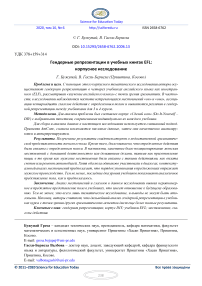Gender representation in EFL course books explored through a corpus-based study: a case study
Автор: Bujupaj Gresa, Gashi-Berisha Valbona
Журнал: Science for Education Today @sciforedu
Рубрика: Филология и культура для образования
Статья в выпуске: 6 т.10, 2020 года.
Бесплатный доступ
Introduction. Through this corpus-based case study, the authors examine gender representation in four English as a Foreign Language (ELF) course books, “Exploring English”, through a grammatical perspective. Particularly, the study observes the frequencies of pronouns ‘he’ and ‘she’, the association of fourteen action verbs with a certain gender, and differences in gender representation between Course book 3 and 4. To analyse the issue, a Do-It-Yourself (DIY) corpus is compiled with texts selected and stored individually from each course book. Materials and Methods. A mixed approach is used to collect and analyse the data for this study. By using AntConc, the study firstly retrieves the numerical data which are further analysed and interpreted qualitatively. Results. The findings suggest underrepresentation of women. In addition, certain actions were associated with a particular gender. More specifically, noticeable was the positioning of feminine pronouns with domestic activities or chores such as cooking, while masculine pronouns were linked with actions such as paying bills or repairing cars. Although both genders participated equally in dialogues, the contextual analysis of pronouns suggests that the order of mention in sentences reflects masculine supremacy. Nevertheless, the last two levels of the course books suggest a similar representation of gender as hypothesised. Conclusions. The pronoun and verb analysis in this study revealed the uneven and biased representation of gender in textbooks which is concerning for the future of education. Yet, this is only a case study and findings cannot be generalized. Lastly, the authors consider that further analysis on gender representation in the course books from other grammatical aspects would provide even more comprehensive results.
Gender representation, diy corpus, efl course books, pronouns, action verbs
Короткий адрес: https://sciup.org/147230580
IDR: 147230580 | УДК: 378+159+314 | DOI: 10.15293/2658-6762.2006.13
Список литературы Gender representation in EFL course books explored through a corpus-based study: a case study
- Amerian M., Esmaili F. Language and gender: A critical discourse analysis on gender representation in a series of international ELT textbooks. International Journal of Research Studies in Education, 2015, vol. 4 (2), pp. 3-12. DOI: https://doi.org/10.5861/ijrse.2014.963
- Ashby M. S., Wittmaier B. C. Attitude changes in children after exposure to stories about women in traditional or nontraditional occupations. Journal of Educational Psychology, 1978, vol. 70 (6), pp. 945-949. DOI: https://doi.org/10.1037/0022-0663.70.6.945
- Barton A., Sakwa L. N. The representation of gender in English textbooks in Uganda. Pedagogy. Culture & Society, 2012, vol. 20 (2), pp. 173-190. DOI: https://doi.org/10.1080/14681366.2012.669394
- Blumberg R. L. Gender bias in textbooks: A hidden obstacle on the road to gender equality in education. Paper Commissioned for the EFA Global Monitoring Report, 2008. URL: http://www.rosadoc.be/digidocs/dd-000658_2007_gender_bias_in_textbooks.pdf
- Blumberg R. L. The invisible obstacle to educational equality: gender bias in textbooks. Prospects, 2008, vol. 38 (3), pp. 345-361. DOI: https://doi.org/10.1007/s11125-009-9086-1
- Butler J. Gender Trouble: Feminism and the Subversion of Identity, 2002, New York, Routledge. URL: http://b-ok.org/s/?q=gender+trouble&yearFrom=&yearTo=&language=&extension=&t=0
- Coles G. Dick and Jane grow up: Ideology in adult basic education readers. Urban Education, 1977, vol. 12 (1), pp. 37-53. DOI: https://doi.org/10.1177/0042085977121003
- Emilia E., Moecharam N. Y., Syifa I. L. Gender in EFL classroom: Transitivity analysis in English textbook for Indonesian students. Indonesian Journal of Applied Linguistics, 2017, vol. 7 (1), pp. 206-214. DOI: https://doi.org/10.17509/ijal.v7i1.6877
- Gharbavi A., Mousavi S. A. The application of functional linguistics in exposing gender bias in Iranian high school English textbooks. English Language and Literature Studies, 2012, vol. 2 (1), pp. 85-93. DOI: https://doi.org/10.5539/ells.v2n1p85
- Gupta A. F., Yin A. S. L. Gender representation in English language textbooks used in the Singapore primary schools. Language and Education, 1990, vol. 4 (1), pp. 29-50. DOI: https://doi.org/10.1080/09500789009541271
- Hyseni H., Llunji V., Kabashi-Hima A. Gender equality in the reading textbooks during the nine years of compulsory education in Kosovo, 2007. Kosova Education Center, Prishtina. URL: http://www.kec-ks.org/wp-content/uploads/2016/03/Gender-equality-in-the-reading-textbooks-during-the-nine-years-of-compulsory-education-in-Kosovo- 1.pdf
- Jones M. A., Kitetu C., Sunderland J. Discourse roles, gender and language textbook dialogues: who learns what from John and Sally? Gender and Education, 1997, vol. 9 (4), pp. 469-490. DOI: https://doi.org/10.1080/09540259721204
- Kirk J., Miller M. L. Reliability and validity in quantitative research. California, Sage Publications, 1986. URL: https: //books.google.nl/books?hl=en&lr&id=YDFZlq_KM88C&oi=fnd&pg=PA5&dq=Reliabilit y+and+validity+in+quantitative+research&ots=uiVaWZnzcy&sig=A9_P0JMLbTDTGSh4RdWq iG0dxTY&redir_esc=y#v=onepage&q=perspectiv&f=false
- Lee J. F. Gender representation in Japanese EFL textbooks - a corpus study. Gender and Education, 2018, vol. 30 (3), pp. 379-395. DOI: https://doi.org/10.1080/09540253.2016.1214690
- Lee J. F., Collins P. Gender voices in Hong Kong English textbooks - Some past and current practices. Sex Roles, 2008, vol. 59 (1-2), pp. 127-137. DOI: https://doi.org/10.1007/s11199-008-9414-6
- Lewandowski M. Gender stereotyping in EFL grammar textbooks: A diachronic approach. Linguistic Online, 2014, vol. 68 (6), pp. 83-99. URL: https://bop.unibe.ch/linguistik-online/article/view/1635
- Mineshima M. Gender representations in an EFL textbook. Bulletin of Niigata Institute of Technology, 2008, vol. 13, pp. 121-140. URL: http://nirr.lib.niigata-u.ac.jp/bitstream/10623/20259/1/13_121-140.pdf
- Porreca K. L. Sexism in current ESL textbooks. TESOL Quarterly, 1984, vol. 18 (4), pp. 704-724. DOI: https://doi.org/10.2307/3586584
- Sapir E. The status of linguistics as a science. Language, 1929, vol. 5 (4), pp. 207-214. URL: http: //www .j stor.org.sheffield.idm .oclc.org/stable/409588?seq=1#page_scan_tab_contents
- Sunderland J., Cowley M., Rahim F. A., Leontzakou C., Shattuck J. From bias "in the text" to "teacher talk around the text": An exploration of teacher discourse and gendered foreign language textbook texts. Linguistics and Education, 2000, vol. 11 (3), pp. 251-286. DOI: https://doi.org/10.1016/S0898-5898(00)00034-6
- Tacium D. "Judith Butler, Gender Trouble: Feminism and the Subversion of Identity, (New York: Routledge, 1990)". Surfaces, 1993, vol. 3. DOI: https://doi.org/10.7202/1065107ar
- Yang C. C. R. Is Gender stereotyping still an issue? An analysis of a Hong Kong primary English textbook series. Online Submission, 2012, vol. 13 (2), pp. 32-48. URL: https://files-eric-ed-gov.sheffield.idm.oclc.org/fulltext/ED545382.pdf
- Zeldes A. "Tony McEnery, Richard Xiao & Yukio Tono. 2006. Corpus-Based Language Studies. An Advanced Resource Book (Routledge Applied Linguistics). London, New York: Routledge. xx, 386 S". Zeitschrift für Rezensionen zur germanistischen Sprachwissenschaft, 2010, vol. 2 (2). DOI: https://doi.org/10.1515/zrs.2010.050


